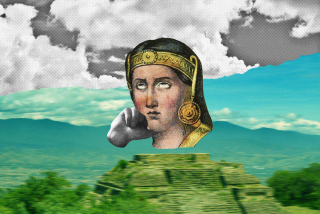Book Review : Columbus: Possessed and Obsesssed
- Share via
Christopher Columbus: The Life, the Quest, the Voyages and Their Aftermath by Gianni Granzotto; translated by Stephen Sartarelli (Doubleday: $18.95)
During the 15th and 16th centuries, the invisible barriers that circumscribed the life of Europe lifted in a great surge of exploration. Within three decades, Europeans discovered the Americas, rounded the tip of Africa and voyaged to India and, the most heroic of accomplishments, circumnavigated the globe. Portuguese led the way followed almost immediately by the Spanish. This was the Great Age of Discovery.
In October, 1492, Christopher Columbus landed in the New World. Since then, commentators have debated virtually every aspect of his life. The Columbus Question is a case study in historical research methodology and historiography. He was a Genoese Catholic or a Spanish Jew; expert navigator or novice seaman; dreamer or madman; motivated by religion or solely seeking gold; university educated or streetwise; searching for Cathay or new islands in the Atlantic. At the 1892 Chicago Colombian Exposition there were 71 portraits of the great discoverer--no two were alike.
Columbus was born in Genoa in 1451, moved to Lisbon when he was about 25, failed to secure royal funding for an Atlantic expedition and relocated to Spain in 1485. It was during his Portugese period that he developed his passionate belief in a Western route to the Orient-- buscar el levante por el poniente , to reach the East by sailing West. He was experienced plying the Atlantic from Iceland to Africa, a capable cartographer, widely read in scientific and philosophical treatises and perhaps most important, believed he was predestined, chosen for a mission. In 1486, Columbus received a retainer from the Spanish crown, but support for his proposed Enterprise of the Indies was all but dead until the climate changed dramatically following the expulsion of the Moors from Spain in early 1492.
The image most Americans have of Columbus is of a man whose expeditions represented a triumph of the enlightened mind over superstition and ignorance. This is the traditional view, first developed in the late 18th Century, enhanced in the 19th Century and enshrined after the quadricentennial celebrations.
The late Gianni Granzotto, the respected Italian novelist, presents a dynamic view of a complex individual as seen against the panorama of western Europe in the late 15th Century. The book is superbly translated by Stephen Sartarelli, conceived in the imagination of the poet and told with the grace of epic drama. The intrepid daring and sense of great adventure come alive on these pages.
We are presented with a man whose life was consumed with explorations to the Indies. In many respects, he had no personal life and virtually this entire study is devoted to the public figure. There are more comprehensive studies and more narrowly focused works, but none deals as effectively with his psychological and intellectual framework and their place in the overall picture of Columbus’ contribution.
Medieval Origins
Columbus is solidly part of the ancient and medieval world, and his eschatological structure reflects these roots. Granzotti provides an excellent analysis of the ancient and medieval origins of Columbus’ cosmology and geography. The biographer could have developed an even stronger argument for Columbus’ apocalypticism by citing Columbus’ consistent use of the signature Christoforens (a Latinization of his name meaning Christbearer) and Bartolome de la Casa’s map showing Columbus as the bearer of Christ to the New World. A more detailed evaluation of primary and secondary sources, especially Columbus’ “Book of Prophecies,” would have been useful. There is strong evidence to suggest that Columbus viewed himself as on a divine mission, or pilgrimage, culminating in the redemption of the Holy Sepulcher.
The explorer developed physical infirmities, became obsessed with the crusade to reach the East, paranoid about the actions of other navigators and convinced that he was entitled to the most extravagant temporal benefits. His poor administrative abilities, his initiation of the slave trade and gradual break with reality alienated him from the Court. Columbus was both obsessed and possessed. His behavior, as described by Granzotto, clearly crossed that delicate line separating genius from insanity.
His death in 1506 went unreported in the local newspapers. In 1519, Magellan invalidated his claims of reaching China and Japan. The New World was named America, not Colombia, and it was the fate of the Admiral of the Ocean Sea to remain in obscurity for three centuries. Gianni Granzotto has left us a fine book as we approach the quincentennial.
More to Read
Sign up for Essential California
The most important California stories and recommendations in your inbox every morning.
You may occasionally receive promotional content from the Los Angeles Times.













